 W
WThe January 2013 Rif Dimashq airstrike was an aerial attack in the Rif Dimashq Governorate of Syria, which targeted a convoy alleged to be carrying weapons from Syria to the Lebanese Shi'a militia Hezbollah. The convoy was attacked on 31 January 2013. According to several media sources, Israeli forces allegedly conducted the strike, however Israel hasn't officially responded to the allegations.
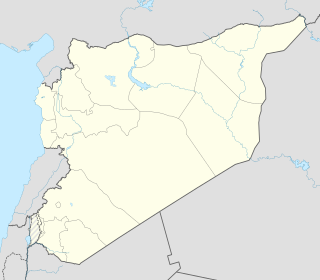 W
WOn 21 February 2013 a series of car bombs were detonated in Damascus killing 83 people. The largest and deadliest of the bombs occurred near the headquarters of the Syria's ruling Ba'ath Party and the Russian Embassy, killing at least 60. Most of the victims were civilians including children.
 W
WThe May 2013 Rif Dimashq airstrikes were a series of aerial attacks made on targets in Syria on 3 and 5 May 2013. The 3 May attack was on targets at Damascus International Airport. The 5 May attacks were on targets at Jamraya, and the Al-Dimas and Maysalun areas in Rif Dimashq. Although officially Israel neither confirmed nor denied its involvement, former Mossad director Danny Yatom and former government member Tzachi Hanegbi inferred Israel's involvement in the attack. Official Syrian sources denied any attack on its soil on 3 May, but did accuse Israel for the attacks on 5 May.
 W
WThe al-Hasakah Governorate campaign was a multi-sided military conflict between Syrian government forces, Kurdish forces, armed Syrian opposition groups, and Salafist jihadist forces, including al-Qaeda's Islamic State of Iraq and the Levant and the al-Nusra Front in the al-Hasakah Governorate as part of the Syrian Civil War. The clashes began with the People's Protection Units (YPG)'s entrance into the civil war in July 2012 and spread across the governorate.
 W
WThe al-Qusayr offensive was an operation by the Syrian Government forces against Opposition forces at al-Qusayr in Homs province, during the Syrian Civil War. The operation was launched on 4 April 2013. The Syrian Army, the Lebanese militia Hezbollah and the National Defense Forces played key roles in the attack. Its aim was to capture all villages around the rebel-held town of al-Qusayr, thus tightening the siege of the city and ultimately launching an attack on al-Qusayr itself. The region was an important supply route for rebels fighting Syrian government forces in Homs.
 W
WOperation al-Shabah was launched in May 2013 by the Iraqi Army, with the stated aim of severing contact between the Islamic State of Iraq and the Levant and the al-Nusra Front in Syria by clearing militants from the border area with Syria and Jordan.
 W
WThe October–December 2013 Aleppo offensive or Operation Northern Storm was a campaign during the Syrian civil war launched by the Syrian army in the Aleppo Governorate to reopen a key supply route linking central Syria to the largest city, Aleppo. The offensive began when the Syrian Army attacked the strategic town of Khanasir.
 W
WThe Battle of Aleppo was a major military confrontation in Aleppo, the largest city in Syria, between the Syrian opposition against the Syrian government, supported by Hezbollah, Shia militias and Russia, and against the Kurdish-majority People's Protection Units (YPG). The battle began on 19 July 2012 and was part of the ongoing Syrian Civil War. A stalemate that had been in place for four years finally ended in July 2016, when Syrian government troops closed the rebels' last supply line into Aleppo with the support of Russian airstrikes. In response, rebel forces launched unsuccessful counteroffensives in September and October that failed to break the siege; in November, government forces embarked on a decisive campaign that resulted in the recapture of all of Aleppo by December 2016. The Syrian government victory is widely seen as a turning point in Syria's civil war.
 W
WThe Battle of al-Yaarubiyah was fought in late October 2013 at al-Yaarubiyah, a strategically important town at the border of Syria with Iraq. Affiliates of the Democratic Union Party (PYD), namely the YPG/YPJ and local Arab tribes, attacked the settlement in an attempt to capture it from Jihadist and Islamist groups, led by the Al-Nusra Front and the Islamic State of Iraq and the Levant. After four days of heavy fighting, the Islamists were defeated and expelled from al-Yaarubiyah.
 W
WThe Bayda and Baniyas massacres were two widely reported on massacres that occurred in May 2013 in the village of Bayda and the city of Baniyas, in Tartus Governorate, Syria, where Syrian Army troops, supported by paramilitaries, killed civilians in the Sunni village respectively the Sunni part of the city. The killings were supposedly in retaliation for an earlier rebel attack near the town that left at least half a dozen soldiers dead.
 W
WThe Damascus offensive (2013) refers to a series of rebel operations that began in early February 2013 in and around the city of Damascus.
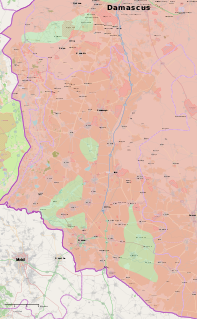 W
WThe 2011–2013 Daraa Governorate clashes are a series of military confrontations between the Syrian Army and the Free Syrian Army in Daraa Governorate, Syria, which began in November 2011, after widescale protests and crackdown on protesters in Daraa had lasted since April 2011. The clashes had been ongoing as part of the Syrian civil war, until the U.N. brokered cease fire came into effect on 14 April 2012. Sporadic clashes continued since then, however.
 W
WThe 2013 Daraa offensive was a campaign during the Syrian Civil War launched by the FSA in the Daraa Governorate to capture the strategic border area. The offensive began in early March 2013. During the campaign, rebel forces captured several bases and towns. The offensive was eventually halted following an Army counter-offensive in mid-April, which resulted in the recapture of a few towns and villages. After that, the rebels continued their advance by launching a counter-offensive of their own.
 W
WThe Siege of Darayya and Muadamiyat was launched by the Syrian Armed Forces in late 2012 after rebels took over most of the Damascus suburbs of Darayya and Muadamiyat al-Sham in November 2012. Since then, the power grid in the area was cut off as the government attempted to storm the towns multiple times. During the siege the towns were continuously hit by airstrikes from the Syrian Air Force.
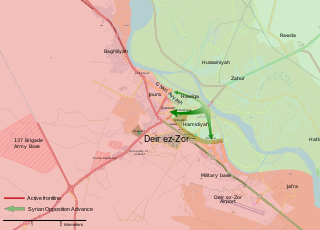 W
WProtests against the Syrian government and violence had been ongoing in the Syrian city of Deir ez-Zor since March 2011, as part of the wider Syrian Civil War, but large-scale clashes started following a military operation in late July 2011 to secure the city of Deir ez-Zor. The rebels took over most of the province by late 2013, leaving only small pockets of government control around the city of Deir ez-Zor.
 W
WThe Siege of Eastern Ghouta was a siege that was laid by Syrian Government forces in April 2013, to the area in eastern Ghouta held by anti-government forces since November 2012, during the Syrian Civil War. The cities and villages under siege were Douma, Mesraba, Arbin, Hamouria, Saqba, Modira, Eftreis, Jisrin, as well as suburbs of Damascus Beit Sawa, Harasta, Zamalka, Ein Tarma, Hazeh and Kafr Batna. By 2016, around 400,000 people were trapped in an area just over 100 square kilometres in size, thus with a population density around 4,000 inhabitants/km2.
 W
WThe Ghouta chemical attack occurred in Ghouta, Syria, during the Syrian civil war, in the early hours of 21 August 2013. Two opposition-controlled areas in the suburbs around Damascus were struck by rockets containing the chemical agent sarin. Estimates of the death toll range from at least 281 people to 1,729. The attack was the deadliest use of chemical weapons since the Iran–Iraq War.
 W
WThe 2012 Hama offensive was a military operation during the Syrian Civil War launched by the Syrian opposition on 16 December 2012, with the intent of taking control of the Hama Province. The offensive was stopped after the Syrian Army launched a counter-offensive, leaving the rebels in control of only half a dozen towns and villages in the north of the province.
 W
WThe 2013 Hama offensive was a military operation launched by Syrian rebels during the Syrian Civil War in the eastern part of the province of Hama, in an attempt to open up a new front, after rebel attacks in the governorate had stalled. The rebels managed to capture 10 villages during their offensive. However, the Army soon retaliated and reversed all of the rebels gains, as well as capturing the town of Halfaya, which the rebels captured during their previous offensive, five months earlier.
 W
WThe Hatla massacre was the killing of 30 to 60 Shia villagers, including some who were armed, conducted by Syrian opposition fighters and Salafist Al-Nusra Front members in the eastern Syrian village of Hatla, near Deir ez-Zor, on 11 June 2013 during the Syrian Civil War. At least 30 of the dead were civilians. According to a UN report, 30 people were killed.
 W
WThe siege of Homs was a military confrontation between the Syrian military and the Syrian opposition in the city of Homs, a major rebel stronghold during the Syrian Civil War. The siege lasted three years from May 2011 to May 2014, and resulted in an opposition withdrawal from the city.
 W
WThe June 2012–April 2013 Idlib Governorate clashes was a series of clashes within the scope of the Syrian civil war, that took place in Syria's Idlib Governorate. The events followed the April 2012 Idlib Governorate Operation by the Syrian government and consequent cease-fire attempt, which had lasted from 14 April to 2 June 2012.
 W
WThe 2013 Latakia offensive, was a campaign during the Syrian Civil War launched by rebel groups led by Salafi jihadists in the Latakia Governorate. The stated aim of the offensive was to conquer al-Haffah city, but government supporters assumed conquering Mount Nabi Younes was more likely the real aim. A calculated side effect may have been to spark more sectarian violence in Syria by carrying out a sectarian attack on an Alawite-majority area. The offensive began in early August 2013. During the campaign, rebel forces captured a dozen villages. However, in mid-August, the military counter-attacked and recaptured all of the territory previously lost to the rebels.
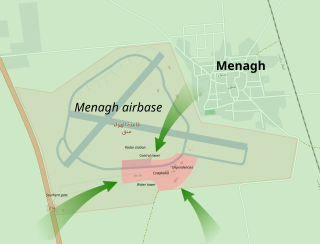 W
WThe Siege of Menagh Air Base was an armed confrontation between the Free Syrian Army and aligned Islamist rebel groups on one hand, and the Syrian Armed Forces on the other.
 W
WOperation Canopus Star was an operation launched by the Syrian Army, supported by Hezbollah and other allied militias, during the Syrian Civil War, following a successful offensive which re-established the military's supply route between Aleppo and central Syria. The aim of the operation was to encircle Aleppo and cut rebel supply lines into the city, thus besieging rebel-held areas.
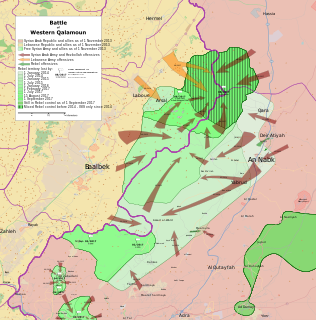 W
WThe Battle of Qalamoun started on 15 November 2013, with air strikes on the town of Qara, in the strategic Qalamoun region, in an attempt by the Syrian Army to cut rebel supply lines to Damascus from Lebanon. The strategic region had been used by rebel forces as a rear base for its operations around the capital Damascus. For its part, government forces had been using the nearby highway to link Damascus with the central Homs province and had multiple weapons depots in the area. The battle was primarily led on the rebel side by the Al-Nusra Front.
 W
WThe Battle of Raqqa, code named by rebels as the "Raid of the Almighty", was a battle for control of the northern Syrian city of Raqqa during the Syrian Civil War between mainly Sunni Islamist rebel insurgents and the Syrian Arab Army. Rebel forces launched the offensive in early March 2013, and declared themselves in "near-total control" on 5 March 2013, making it the first provincial capital claimed to come under rebel control in the civil war. The battle, on the opposition side, was primarily led by the al-Nusra Front and Ahrar al-Sham.
 W
WThe Raqqa campaign (2012–13) was a series of battles and offensives launched by various Syrian rebel groups, led by the al-Nusra Front, against Syrian government forces in the Raqqa Governorate as part of the Syrian Civil War. The campaign was launched at the second half of 2012 and ended in the capture of the city of Raqqa as well as dozens of smaller towns and facilities.
 W
WThe Battle of Ras al-Ayn was a series of armed clashes for control of the town of Ras al-Ayn during the Syrian Civil War, mainly between the Kurdish-majority People's Protection Units (YPG) and an alliance with Syrian rebel groups, with the occasional involvement of the Syrian Armed Forces. As result of the battle's first phase, the Syrian Army was expelled from the city by Syrian rebels, whereupon the latter attacked the YPG-affiliated fighters in Ras al-Ayn. In the following months, the city was effectively divided into rebel-held and YPG-held areas, with intermittent fighting resulting in the gradual expansion of the YPG's territory in the city and its surroundings. Islamist and jihadist factions soon became dominant among the rebels in the region, further contributing to tensions with the secular-leftist YPG. In July 2013, the battle's final phase erupted and ended when an alliance of YPG-led troops completely expelled the rebels from Ras al-Ayn.
 W
WThe Rif Dimashq offensive refers to a rebel offensive during the Syrian Civil War in the Rif Dimashq Governorate which started in November 2012, and a subsequent attempted Syrian Army counterattack in January 2013. Thomson Reuters described rebels as "ramping up attacks on Damascus" in late November and BBC News described the 29 November government counterattack as "an unprecedented offensive against rebel-held districts in the east of the city".
 W
WThe Rif Dimashq offensive was a Syrian government forces and allies offensive in the Rif Dimashq Governorate that was launched in late March 2013, as part of the Syrian Civil War.
 W
WThe Rif Dimashq offensive was a Syrian government forces and allies offensive in the Rif Dimashq Governorate, that was launched in mid-September 2013, as part of the Syrian Civil War.
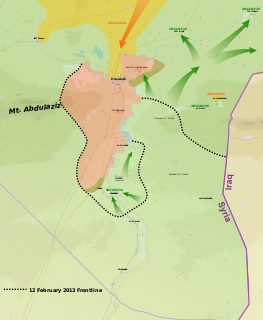 W
WThe Battle of Shadadeh was a three-day-long battle fought between government forces loyal to Syrian President Bashar al-Assad and Islamist Al-Nusra Front fighters in the city of Shadadeh, located near the Iraqi border.
 W
WThe Siege of Nubl and al-Zahraa during the Syrian Civil War was laid by rebels to capture two Syrian government-held towns north of Aleppo, after they had seized most of the northern countryside in July 2012. The siege was lifted on 3 February 2016, as a result of a Syrian government offensive.
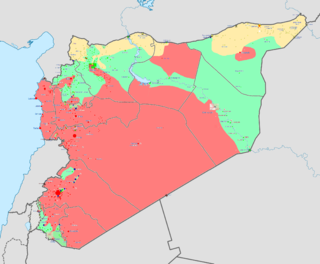 W
WThe 2013 Battle of Tell Abyad was a military confrontation in the town of Tell Abyad between the Kurdish Front and the Democratic Union Party (Syria)-affiliated People's Protection Units and Women's Protection Units against the Islamic State of Iraq and the Levant, the al-Nusra Front, and Ahrar al-Sham, resulting in a Kurdish defeat and the jihadist capture of the town.
 W
WThe Siege of Wadi Deif refers to the siege of two Syrian Army bases, Wadi Deif and Hamadiyah, by rebel forces, starting on 11 October 2012, during the Idlib Governorate clashes of the Syrian civil war.